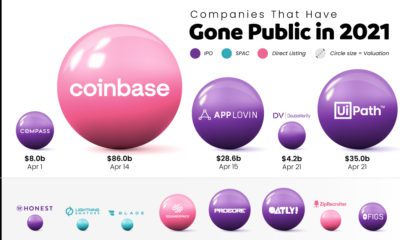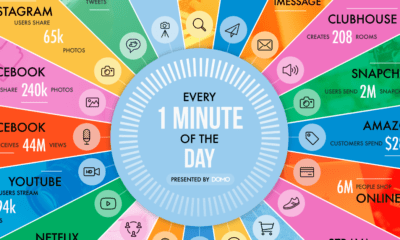The world needs infrastructure, and the world needs it soon. It’s not just about replacing aging pieces of infrastructure like bridges and roads – it’s also about developing modern infrastructure that enables new technology, faster communications, and our ability to use, move, and transmit energy from renewables and natural gas. Today’s infographic comes to us from Miller Howard Investments and it details five specific ways that investors could play the coming infrastructure boom.
Five Ways to Play The Infrastructure Boom
Here are some of the happening areas within infrastructure, and why:
- Utilities The utilities sector will by driven by growth in EVs, renewable energy, abundance of U.S. oil and gas, and smart grid technology.
If all U.S. vehicles were EVs, it would mean an immediate 25% boost to electricity demand In 2016, more money was invested in solar and wind than all other electricity sources combined
- Global Communications Comms will be buoyed by the rapid growth of 5G, as well as the IoT and its impact on ecommerce.
Wireless data use: 96 exabytes per month (EB/mo) to 278 EB/mo between 2016 and 2021 The U.S. will capture the largest share of the 5G value chain
- Energy Infrastructure Aging infrastructure needs to be updated, while more capacity for electric and O&G transmission is needed.
Between 2013-2030, it’s estimated $4.64 trillion will need to be invested in U.S. energy infrastructure By 2035, the U.S. will have net exports of 35 billion cubic feet (Bcf) per day of natural gas
- Transportation and Logistics More goods need to get to more places. Transportation and logistics will benefit tremendously from the growth of ecommerce, smart warehouses, cloud-based logistics-as-a-service, and delivery innovation.
By 2020, global ecommerce sales is expected to eclipse the $4 trillion mark Parcel shipment volume is accelerating to grow at a higher rate each year
- Enablers Big data, 5G and IoT, and increased automation are enabling bigger trends, such as EVs and smart homes.
By 2040, it’s estimated that 54% of all new car sales will be electric Meanwhile, the internet of things is exploding to 75.4 billion things by 2025
on
#1: High Reliability
Nuclear power plants run 24/7 and are the most reliable source of sustainable energy. Nuclear electricity generation remains steady around the clock throughout the day, week, and year. Meanwhile, daily solar generation peaks in the afternoon when electricity demand is usually lower, and wind generation depends on wind speeds.As the use of variable solar and wind power increases globally, nuclear offers a stable and reliable backbone for a clean electricity grid.
#2: Clean Electricity
Nuclear reactors use fission to generate electricity without any greenhouse gas (GHG) emissions.Consequently, nuclear power is the cleanest energy source on a lifecycle basis, measured in CO2-equivalent emissions per gigawatt-hour (GWh) of electricity produced by a power plant over its lifetime. The lifecycle emissions from a typical nuclear power plant are 273 times lower than coal and 163 times lower than natural gas. Furthermore, nuclear is relatively less resource-intensive, allowing for lower supply chain emissions than wind and solar plants.
#3: Stable Affordability
Although nuclear plants can be expensive to build, they are cost-competitive in the long run. Most nuclear plants have an initial lifetime of around 40 years, after which they can continue operating with approved lifetime extensions. Nuclear plants with lifetime extensions are the cheapest sources of electricity in the United States, and 88 of the country’s 92 reactors have received approvals for 20-year extensions. Additionally, according to the World Nuclear Association, nuclear plants are relatively less susceptible to fuel price volatility than natural gas plants, allowing for stable costs of electricity generation.
#4: Energy Efficiency
Nuclear’s high energy return on investment (EROI) exemplifies its exceptional efficiency. EROI measures how many units of energy are returned for every unit invested in building and running a power plant, over its lifetime. According to a 2018 study by Weissbach et al., nuclear’s EROI is 75 units, making it the most efficient energy source by some distance, with hydropower ranking second at 35 units.
#5: Sustainable Innovation
New, advanced reactor designs are bypassing many of the difficulties faced by traditional nuclear plants, making nuclear power more accessible.
Small Modular Reactors (SMRs) are much smaller than conventional reactors and are modular—meaning that their components can be transported and assembled in different locations. Microreactors are smaller than SMRs and are designed to provide electricity in remote and small market areas. They can also serve as backup power sources during emergencies.
These reactor designs offer several advantages, including lower initial capital costs, portability, and increased scalability.
A Nuclear-Powered Future
Nuclear power is making a remarkable comeback as countries work to achieve climate goals and ultimately, a state of energy utopia. Besides the 423 reactors in operation worldwide, another 56 reactors are under construction, and at least 69 more are planned for construction. Some nations, like Japan, have also reversed their attitudes toward nuclear power, embracing it as a clean and reliable energy source for the future. CanAlaska is a leading exploration company in the Athabasca Basin, the Earth’s richest uranium depository. Click here to learn more now. In part 3 of the Road to Energy Utopia series, we explore the unique properties of uranium, the fuel that powers nuclear reactors.





























